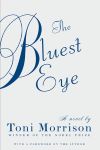Content warning: mentioning of racism, rape
Toni Morrison has created a novelistic language for those who are marginalized in a white, oppressive system. Now, 50 years after the publication of her novel The Bluest Eye, her insights into racism and its severely damaging effects are still as relevant as in 1970.
By Emily Linnéa Lüter
Picture: Via Pexels, gemeinfrei
50 years ago, in 1970, Toni Morrison published her debut novel The Bluest Eye. At the time, she was working as Random House’s first black female senior editor. After studying her way out of her working-class background, she graduated from Cornell University and went on to have a successful career in publishing and writing. Not only her biography, but her achievements as a writer have impressed people around the world and she was awarded with the Nobel Prize in Literature in 1993. It is both remarkable and disturbing how much her novels still reverberate with contemporary concerns. In a year so upset by racism, it is well worth re-reading her works.
Hopes and fears of a young girl
The Bluest Eye tells the story of Pecola, a black girl growing up in Lorain, Ohio, in the 1940s. Marred by his encounters with racism, her father Cholly Breedlove has turned to alcohol and abuse while her mother Pauline tries to show her fierce love for her children by beating her husband. It is a poor home of a broken family in which the young girl begins to fall apart. At school, she is branded as ugly and beaten by those who despise her skin colour. As a way of escaping these harsh realities, Pecola begins to wish and pray for blue eyes, the bluest eyes of them all. To look like Shirley Temple would give her the worth others have taken from her. The emotional and physical abuse escalates when Cholly exploits his daughter’s vulnerability and rapes her repeatedly. Even when Pecola moves to a neighbouring family and befriends their daughters Frieda and Claudia, her time in this stable, secure household cannot prevent her downwards spiral, which drags her into madness. Because she is black and poor and a young girl, her fate is set in stone from the very first pages: <blockquote>
What is clear now is that of all of that hope, fear, lust, love, and grief, nothing remains but Pecola and the unyielding earth. Cholly Breedlove is dead; our innocence too. The seeds shrivelled and died; her baby too.
The seeds that Claudia and Frieda planted in their garden as a symbol of hope have withered and so has their friend Pecola. The novel explores the manifold abuses that lead to her disintegration in a profound and layered way.
The novel is mostly told from the limited homodiegetic perspective of Claudia. Pecola’s and the community’s story is observed through the eyes of an innocent child. But even though – or because of – that innocence, Claudia’s narrative bluntness allows the reader to see Pecola in her rawest state. The abuses she has to endure by other children and her own father seem all the more heart-breaking. However, Morrison denies a straight-forward reading by inserting heterodiegetic flashbacks, which explore the other characters’ backgrounds. Once the readers learn about Cholly’s and Pauline’s past, they may still judge them but they will also understand how their experiences have broken them. In this way, Morrison creates a disrupted narrative structure to delay and defer knowledge. A coherent, omniscient narrative would emotionally distance Pecola’s story from the readers, thus depriving her of her potential to move them. Thus, Morrison places her at the centre of the novel around which the other voices craft their narratives; their insider perspectives include the readers and create a powerful intimacy. The heterodiegetic interludes create a complex whole that encourages the readers to re-think and re-evaluate in an attempt to deny easy judgment and the victimization of Pecola.
Abusers and the abused
At the heart of The Bluest Eye lies the concept of colourism. The idea of skin colour as a marker for moral and social worth is so ingrained in bpoc of the 1940s in Ohio that they turn their discursively nurtured self-hatred towards the weakest member of their community. The young Pecola is constantly described as the darkest-skinned person and in the eyes of Lorain’s bpoc community, her worth is diminished based on that feature. At school, the boys sing »Black e mo. Black e mo.« to insult Pecola for something she cannot change: to them, her skin is a constant reminder of the racism they have to endure. In her afterword from 1993, Morrison explains that her motivation for writing the novel came from her bewilderment at the racial self-loathing her school friend expressed. She wondered, »Who had looked at her and found her so wanting, so small a weight on the beauty scale? The novel pecks away at the gaze that condemned her.«

Toni Morrison
The Bluest Eye
Penguin RandomHouse: New York 2007
240 pages, 14,95$
In the novel, beauty is a white concept. The excerpt from an American Dick and Jane reader that precedes each part becomes a mocking emblem for what the black community strives for: whiteness and its privileges. As the story unfolds, the repeated quote is corroded and subverted. First punctuation and then whole words are cropped to expose the hypocrisy of a reader that postulates whiteness as ideal. No one strives harder and more relentlessly to become the symbolic Shirley Temple than the bcop community does. Those who are marginalised because of their skin colour, in turn, marginalise those who fit least into the idea of white beauty. Therefore, the community fears Pecola’s skin which is a living reminder of the racism directed towards them. Her beauty as a human being is violently taken from her when the people around her use the girl for their own valorization. They feel beautiful in comparison and so she must remain ugly in their perception. Despite the manifold abuses that happen in the novel, this might be the cruellest of them all and it sends Pecola into madness:
The birdlike gestures are worn away to a mere picking and plucking her way between the tire rims and the sunflowers, between Coke bottles and milkweed, among all the waste and beauty of the world—which is what she herself was. All of our waste which we dumped on her and which she absorbed. And all of our beauty, which was hers first and which she gave to us. All of us—all who knew her—felt so wholesome after we cleaned ourselves on her. We were so beautiful when we stood astride her ugliness.
Morrison impressionably describes the tragedy of Pecola’s life, whose beauty is now only found among the waste of the world to which the narrator likens her. When she descends into madness, she becomes fully marginalised not only by others —she becomes a recluse in her own head. The world has shunned her physical reality, so her mind has retreated also.
The power of language
When Toni Morrison won the Novel Prize of Literature in 1993 she said:
Oppressive language does more than represent violence; it is violence; does more than represent the limits of knowledge; it limits knowledge…It is the language that drinks blood, laps vulnerabilities, tucks its fascist boots under crinolines of respectability and patriotism as it moves relentlessly toward the bottom line and the bottomed-out mind. Sexist language, racist language, theistic language—all are typical of the policing languages of mastery, and cannot, do not permit new knowledge or encourage the mutual exchange of ideas.
Her writing is an attempt to rectify the devastating and lasting consequences of the language of oppressors. In her stories, she tries to create a distinctly marginalised voice that more accurately represents American culture in all its shades.
Morrison’s arguably greatest achievement is her mastery of language and the way she exposes the true power of words. She said, »We die. That may be the meaning of life. But we do language. That may be the measure of our lives.« Language not only as communication but as a tool of power and violence has to be re-examined and re-written. Morrison has created a literary language of her own as the measure of her life and has incited a lasting change in the tradition of American storytelling. Her endeavour, however, goes beyond the boundaries of literature. The systems she questions and the racial patterns she exposes are still as present as they were 50 years ago. Sadly, the truth of her works has not lost its importance in today’s world.






